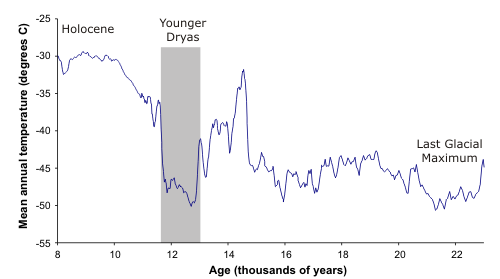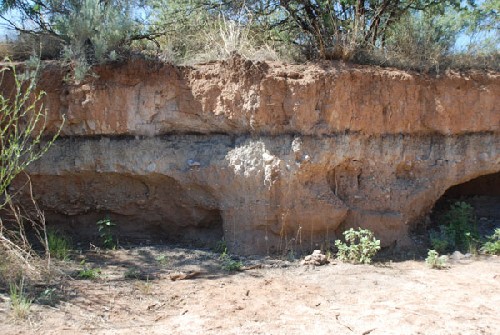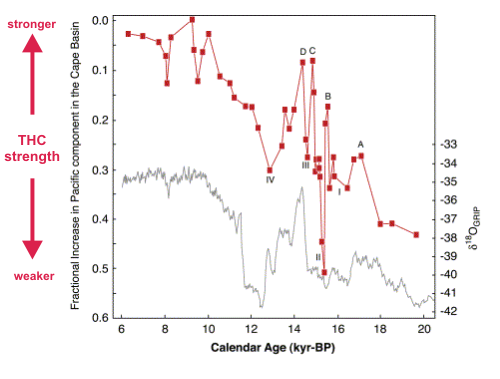21,000 years ago, at the peak of the last glacial, ice sheets covered most of Western Europe and North America; by 10,000 years ago, a warming climate had melted them away. Records from ice and sediment cores all agree that the ice’s retreat back to its strongholds in the Arctic Circle was not smooth, but jerky: the Greenland temperature record, calculated from oxygen isotope variations in the GISP2 ice core, indicates that episodes of more rapid warming and cooling were superimposed on the longer-term warming trend. Particularly prominent is a 1,500 year period between about 13,000 and 11,500 years ago, known as the Younger Dryas, when the mean annual temperature abruptly dropped to levels more typical of the Last Glacial Maximum.

There is evidence that the Younger Dryas cooling, and much of the other shorter-term variability seen earlier in the last deglaciation, are related to fluctuations in the strength of the thermohaline circulation, due to sudden additions of meltwater to its North Atlantic source region. But some scientists, such as Richard Firestone of the Lawrence Berkeley National Laboratory, have been wondering if the particular severity of the Younger Dryas cooling might be the result of a more exotic cause: an asteroid or comet exploding above North America 12,900 years ago.
A paper just out in PNAS by Firestone and a cast of dozens outlines the supporting evidence for an impact event at the beginning of the Younger Dryas. They focus on deposits like these, which have been uncovered at archaeological sites around North America (with at least one equivalent in Western Europe):

(source: Supplementary information)
The black horizon, rich in organic carbon, is always the same age – around 12,900 years – and therefore appears to represent a single event which correlates with the onset of the younger Dryas. It also marks a clear break in the archaeological and palaeontological record: below it, you find lots of distinctive stone tools made by the Clovis culture, some of the earliest human inhabitants of North America, and the bones of Pleistocene megafauna, including mammoths and ground sloths. Above it, there are no Clovis artefacts, and the North American megafauna have abruptly gone extinct. The question becomes, then, what produced the black horizon itself? A close look reveals lots of interesting things:
- Organic carbon was mainly in forms produced in intense fires – charcoal, soot and polycyclic aromatic hydrocarbons.
- Other forms of carbon sometimes found in the layer included nanodiamonds and fullerenes, which are often associated with impacts. The helium trapped in the buckyball cages had much higher proportions of Helium-3 than you would expect for a terrestrial source.
- A large number of magnetic microspherules – interpreted to be formed from the molten ejecta of an impact.
- A noticeable peak in the abundance of iridium, which is much more enriched in extraterrestrial bodies than the Earth’s crust (concentrations were generally below the limit of detection above and below the marker horizon).
Iridium peaks, and spikes of ammonium and nitrate that could have been produced by extensive burning of biomass, are also found in the Greenland ice cores. The authors therefore propose that the black horizon is the result of massive forest fires raging across the whole North American continent, triggered by the fiery impact of a meteorite or comet – or possibly a low altitude explosion like the Tunguska event. Enough soot from the fires, and dust from the impact, would have been thrown into the atmosphere to significantly cool the climate, causing enough environmental stress to wipe out both the Clovis people and the mammoths.
It all seems pretty convincing, which made me wonder how this new hypothesis stacks up against the one I was already familiar with, which attributed the Younger Dryas to a weakening of the thermohaline circulation (THC). So I revisited this paper by Piotrowski et al., which uses neodymium isotopes to estimate how much downwelling water in the North Atlantic was being transported into the deep Southern ocean (see this post for some more details). The plot below – their Figure 4 – compares inferred variations in THC strength with the Greenland ice core record.

I’m struck by the fact that there appears to be a good correlation between the two, with a stronger THC corresponding to warmer temperatures in Greenland and vice versa, except during the Younger Dryas; it is preceded by a weakening of the THC from 13-14 thousand years, but the minimum appears to be reached before the onset of the most rapid cooling at 12.9 thousand years. Perhaps, then, the two mechanisms are complementary, with the chilling effect of an extra-terrestrial impact adding to the temperature drop already caused by a weakening of the thermohaline circulation.



Comments (17)